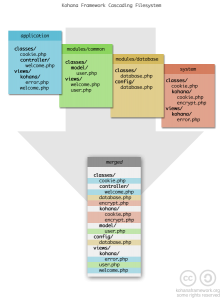Cascading file loading in Node.js
One of my favorite features of Kohana 3 is it's cascading filesystem - so I decided to implement it for Node.js. A cascading filesystem is an elegant solution to a common problem: how to provide a mechanism for loading modules and reusing code?
The following image from Kohana 3's docs shows an example:
Benefits
The key benefits are:- Consistency. All your application files, including views, controllers, models and other data such as translation messages are loaded using one, easy-to-understand mechanism.
- Easy reuse. Without a cascading file system, you'll have to copy and move files around if you want to use someone else's libraries or modules. With a cascading file system, you just place the module in your application, and enable cascading for that directory.
- Transparent extensibility. What if you want to override one part of a module (say, a view) but don't want to modify your copy of the module (e.g. so that you can update without manually merging changes). A cascading filesystem allows you to selectively replace files in 3rd party code simply by providing your own version of the file.
The code
- https://github.com/mixu/hmvc-cfs/
- It's only about 90 lines of code, see this file
Load order and file name resolution
The load order for my implementation is:- Application path - files under ./application/ are always checked first.
- Module paths - set modules(['./modules/my-module']) to enable module loading. Files from modules are loaded from in the order they are added.
- System path - files under ./system/ are loaded if no alternative exists.
Methods
The methods are:- Cfs.modules(['./modules/path-to-module']) - set the modules directories to search.
- Cfs.find_file(dir, file, ext) - Search each path under dir (e.g. 'classes', 'views') for file (filename) with the extension (ext, default is ".js").
- Cfs.factory(class_name) - Return a new instance of the given class after loading the corresponding file from the cascading file system. Note that classes should be in the classes subdirectory.
- Cfs.load(class_name) - Return whatever require(file-which-contains-the-class) returns. Useful for extending classes, see below for an example
Example usage:
var Cfs = require('./cfs.js');
// test class loading:
// e.g. check ./application/classes/test.js
// ./modules/modulename/classes/test.js
// ./system/classes/test.js
var t = Cfs.factory('test');
t.run();
// test view loading
// e.g ./application/views/user/index.html
// ./modules/modulename/views/user/index.html
// ./system/views/user/index.html
fs.readFile(Cfs.find_file('views', 'user/index', '.html'), function (err, data) {
if (err) throw err;
sys.puts(data);
});To set modules:
// set only once, before calling any other functions!
Cfs.modules([
"./modules/testmodule/",
"./modules/testmodule2/",
]);Extending classes:
// test extending class (see code in /application/classes/controller/extend.js
// to see how extension is achieved)
// e.g. ./application/classes/controller/extend.js
// ./modules/modulename/classes/controller/extend.js
// ./system/classes/controller/extend.js
var t3 = Cfs.factory('Controller_Extend');
t3.run();
t3.run_parent();Note that if you put cfs.js in ~/node_modules/cfs.js, you don't need to specify the path to it... see Modules in node.js docs.
// in extend.js:
var ControllerExtend = function () {
}
// extend the class
var util = require('util'), Cfs = require('../../../../cfs.js');
util.inherits(Controller_Extend, Cfs.load('Controller_Base'));
Controller_Extend.prototype.run = function() {
console.log("Controller_Extend from testmodule2.");
};
Controller_Extend.prototype.run_parent = function() {
// run the parent function
Controller_Extend.super.prototype.run();
};
module.exports = Controller_Extend;Comments
shadowhand: Calling this HMVC is highly misleading. The cascading filesystem has absolutely nothing to do with hierarchical model-view-controller. I strongly recommend that you rename your "HMVC" class to something reasonable, such as "CFS".
Mikito Takada: @shadowhand I agree and apologize if I have misled people. I had greater ambitions for the module at the time, hence the "HMVC style" reference, but I ended up doing other things. I've removed any references to HMVC here (well, except the diagram showing the cascading file system in Kohana but that's CFS rather than HMVC); I'll do github as well next time I actually work on that repo...
Edit: for clarification if someone ends up here: the title of this post used to be "HMVC -style cascading..."
